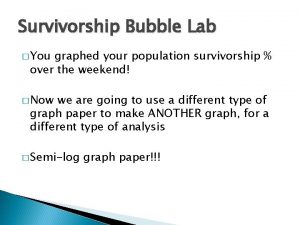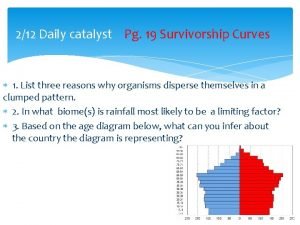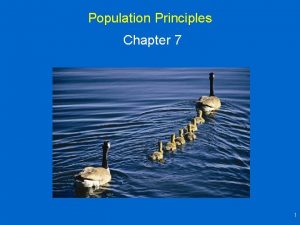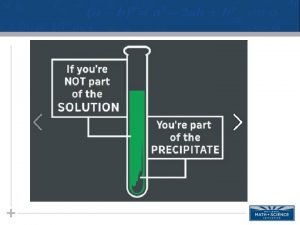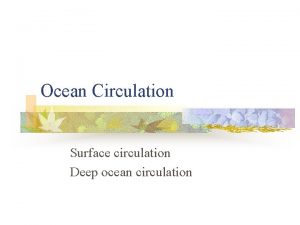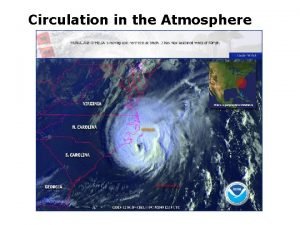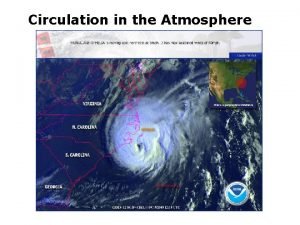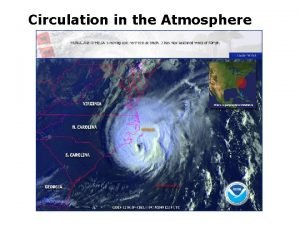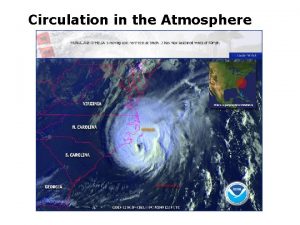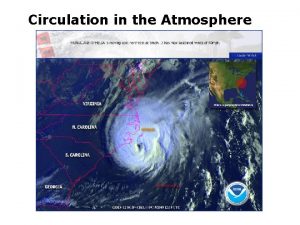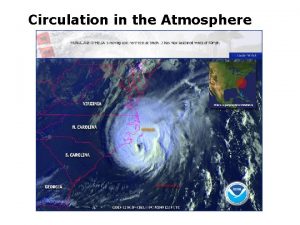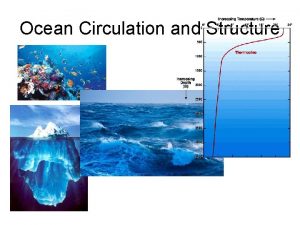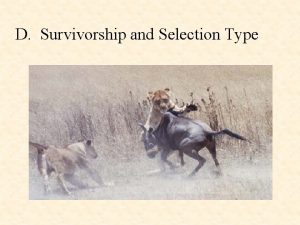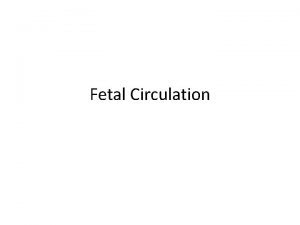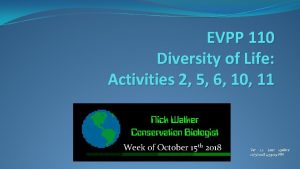EVPP 110 Atmosphere Ocean Circulation Activity 7 Survivorship





















- Slides: 21

EVPP 110 Atmosphere & Ocean Circulation – Activity 7 Survivorship – Activities 1 -2 Week of November 11 2018 Version 1. 3. Last updated: 11/11/2018 9: 23: 26 PM


Atmosphere and Ocean Circulation – Activity 7 – Temperature and Humidity at the Surface

�Temperature and moisture availability are important in determining what types of organisms can live in particular areas. �Temperature affects amount of moisture a given volume of air can hold. �Warm air can hold more moisture than cold air.

�Sling psychrometer: used to determine relative humidity. �Water evaporating from wet bulb reduces temperature relative to dry bulb. �More humidity = water evaporates slower, so less difference between wet and dry bulb. �Less humidity = water evaporates faster, more difference between them.

Relative humidity table (wet/dry bulb method) Difference between wet and dry bulb temp Dry bulb temp. 18° C 10° C Wet bulb temp. Wet cloth wick Reservoir of water Difference between wet bulb and dry bulb = 18 – 10 = 8

Table 7. 1. Wet and dry bulb temperatures (°C), % relative humidity and wind speed (km/h) by group forested location Location Type Forest Group # 1 2 3 4 5 6 Mean Temperature ( C) Wet Bulb Dry Bulb RH (%) Wind Speed (km/h) �Chose four observation locations, one from each category; forest, grass, parking lot and adjacent to a building. �At each location, record in Tables 7. 1 -7. 4 the wet and dry bulb temperatures ( C) and relative humidity (%) with the sling psychrometer + psychrometric table and measure the wind speed with the anemometer.

Record data from all other groups on your data sheets Table 7. 1 Location Type Forest Temperature ( C) Group # Parking Lot Dry Bulb Table 7. 2 RH (%) Wind Speed (km/h) Location Type Temperature ( C) Group # 1 1 2 2 3 3 Field (grass) 4 5 6 6 Mean Temperature ( C) Group # Wet Bulb Dry Bulb Table 7. 4 RH (%) Wind Speed (km/h) Location Type Group # 1 2 2 3 3 Building Dry Bulb RH (%) Wind Speed (km/h) Temperature ( C) 1 4 Wet Bulb 4 5 Table 7. 3 Location Type Wet Bulb 4 5 5 6 6 Mean Wet Bulb Dry Bulb RH (%) Wind Speed (km/h)


Survivorship in Populations – Activity 1 – Human Data Collection

Surviving number of individuals Survivorship Curves Type I Fig. 1. Approximate shapes of Type I, II and III survivorship curves as number of individuals versus percent of potential life span. Type III 0 25 50 100 Percent of maximum life span

�Cemetery data: http: //www. interment. net/data/us/oh/delaware/oakgrove/ �Sample each deceased individual born between 1800 and 1899. Table 1. 1. Surname ranges assigned to each pair for human data collection from online cemetery records Table 1 Table 2 Table 3 A-Fl Fo-O Pa-Z

Sample data Aaron, Ted, b. 1916, d. 1916 Abbott, Anna, b. 1862, d. 01/01/1909, Abbott, Ashford Wellington, b. 05/12/1856, d. 11/15/1932, Abbott, Edith, b. 03/26/1885, d. 10/17/1961, Abbott, H. B. , b. 03/--/1889, d. 03/18/1889 Abbott, Ella Josephine, b. 1860, d. 12/26/1957 Abbott, Frank Richard, b. 06/30/1919, d. 04/12/1980 Adair, Frank Byers, b. 1877, d. 07/--/1877, �For each sampled individual, record gender and age at death. Table 1. 2. Age at death data for individuals by gender, collected by a student pair • • Don’t sample, not born between 1800 -1899. Sample, assume female. Don’t sample, gender unknown. Sample, assume female. Don’t sample, not born between 1800 -1899. Sample, assume male. Males Females Birth year Death year Age at death 1856 1932 76 1862 1909 47 1877 0 1885 1961 76 1860 1957 97

Compile data from Table 1. 2 into Table 1. 3 �Review Table 1. 2 data collected by each group. �Place tick marks as you compile data into “tally” column. �Determine number of males and females that died in each age category. Table 1. 3. Student pair data for age at death by gender compiled into group data for age at death by age class and gender Age class <1 1 -4 5 -9 10 -14 15 -19 Male deaths Tally Total 5 Female deaths Tally Total

Table 1. 4. Age at death data by gender and age class for all groups Age Class Male Deaths (by table) 1 2 3 Total <1 1 -4 5 -9 10 -14 15 -19 20 -24 25 -29 30 -34 35 -39 40 -44 45 -49 50 -54 �Transfer group data to Table 1. 4. Female Deaths (by table) 1 2 3 Total

Data for humans �Transfer data from Table 1. 4 to 1. 5. Table 1. 5. Number of deaths and surviving individuals by age class for males, females and males + females combined for class-wide data Age Class <1 1 -4 5 -9 10 -14 15 -19 Males Females Males + Females # deaths # surviving 2 248 4 246 6 494 6 242 6 240 12 482 1 1 240 3 2 237 235 4 3 478 475

Survivorship in Populations – Activity 2 – Comparison Curves

Table 2. 1. Human survivorship data as number and percent surviving by age class for class-wide data from Activity 1 Age Class # Age Range for Class (years) 0 1 Initial pop. Size 0 -14 2 3 4 5 6 7 8 15 -29 30 -44 45 -59 60 -74 75 -89 90 -104 105 -110 Human Survivorship # surviving % surviving 500 475 100 95 �Consolidate data from Table 1. 5 in Activity 1 into Table 2. 1. �Condense data into the smaller number of age classes shown in Table 2. 1. �Complete Table 2. 1 by calculating the % surviving in each age class.

Table 2. 2. High Arctic moth survivorship data as number and percent surviving by age class Age Class # Age Range for Class (Stage) 0 1 Egg (= initial pop. Size) Instar I 2 3 4 5 6 7 8 Instar III Instar IV Instar VI Pupa Adult moth High Arctic Moth Survivorship # surviving % surviving 85 100 71 59 49 26 14 7 2 1 �Calculate % surviving in each age class, using “# surviving” data.

100 Discussion Questions 1 2 3 4 6 7 8 9 8 5 7 4 6 3 5 2 80 70 60 50 40 30 20 Age class 9 10 0 Fig 2. 1. Survivorship as percent of survivors by age class (no units) for humans, ground squirrels, bull trout, annual bluegrass, high arctic moth and finch. 90 % of surviving colonies �Graph % surviving data by age class for humans and five species (Fig 2. 1). �Graph will have six lines. �Label each line or use different color/patterns. 0 1

What’s Due Activity Weekly Data Sheet pages Atm 7 Sur 1 Sur 2 331, 336 419, 427, 431 Weekly Write-Up pages 339 -340 435 -437 441, 445, 449, 453, 454 Power. Point available at: https: //eeltown. org/evpp-110
 Single vs double circulatory system
Single vs double circulatory system Single circulation and double circulation
Single circulation and double circulation Alveoli
Alveoli 110-000-110 & 111-000-111
110-000-110 & 111-000-111 Numero niss
Numero niss Slowing atlantic ocean circulation
Slowing atlantic ocean circulation Ocean atmosphere and climate
Ocean atmosphere and climate Ocean atmosphere and climate
Ocean atmosphere and climate Atmosphere ocean
Atmosphere ocean Bubble lab survivorship
Bubble lab survivorship Bubble survivorship lab answer key
Bubble survivorship lab answer key Survivorship curve
Survivorship curve K selected species survivorship curve
K selected species survivorship curve Ecology def
Ecology def Type 1 survivorship examples
Type 1 survivorship examples Survivorship bias
Survivorship bias K selected species survivorship curve
K selected species survivorship curve Types of life table
Types of life table Survivorship vancouver
Survivorship vancouver Type 1 survivorship
Type 1 survivorship Ocean to ocean convergent boundary
Ocean to ocean convergent boundary Ocean ocean convergent boundary
Ocean ocean convergent boundary









